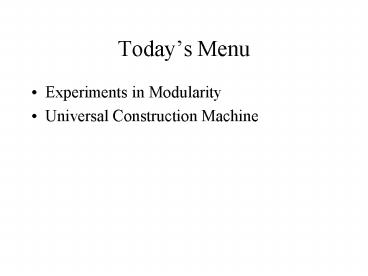Today - PowerPoint PPT Presentation
Title:
Today
Description:
Introduced directly by developmental mechanisms, duplication/splicing operators ... Individual creature (transfer function) Arbitrary survival requirement ... – PowerPoint PPT presentation
Number of Views:23
Avg rating:3.0/5.0
Title: Today
1
Todays Menu
- Experiments in Modularity
- Universal Construction Machine
2
Regularity vs. Modularity
- Regularity (structural)
- Repeated/symmetric/self-similar patterns
- Allows for compressed description
- Introduced directly by developmental mechanisms,
duplication/splicing operators - Can also result from
- environment pressure
3
Regularity vs. Modularity
- Modularity (functional)
- Decoupled parts serve different functions
- Extreme one of each module exhibits no
regularity - Can be introduced directly from developmental
mechanisms, grammars (e.g. trees)
duplication/splicing operators - Can also result from environment pressure
4
Environment directs modularity
How environmental changes provide pressure for
functional modularity
performance individual environment success
requirement performance
Environment building blocks
Individual creature (transfer function)
Arbitrary survival requirement
5
Rules of the game
- Fitness number of requirements fulfilled
- Operators Only uniform mutation of matrix (flat)
- Environment Occasionally mutated
- Modularity Number of nonzero elements (block
diagonal)
Environment building blocks
Individual creature (transfer function)
Arbitrary survival requirement
6
Rules of the game
- Fitness number of requirements fulfilled
- Operators Only uniform mutation of matrix (flat)
- Environment Occasionally mutated
- Modularity Number of nonzero elements (block
diagonal)
Environment building blocks
Individual creature (transfer function)
Arbitrary survival requirement
7
Implementation
- High mutation noise drowns effects
- Direct fitness proportionate too weak
- Boltzman T0.1-0.3 for F0-1
- Population 500, steady state
8
Matrix Size 8 100K Evaluation, Popsize 500, Boltz
0.1 Redchange every 40000 evaluations Bluechange
every 10000 evaluations Population not
re-evaluated after change
9
Matrix Size 8 4M Evaluation, Popsize 500 8000
Generations, Boltz 0.1 Redchange every 40000
evaluations Bluechange every 10000
evaluations Population not re-evaluated after
change
10
Matrix Size 8 4M Evaluation, Popsize 500 8000
Generations, Boltz 0.1 Redchange every 40000
evaluations Bluechange every 10000
evaluations Population re-evaluated after change
11
Average of 10 runs, over 10 samples Matrix Size
8 100,000 Evaluation, Popsize 500 200
Generations, Boltz 0.1 Blue, Redchange every
evaluations (no change) Green, Magentachange
every 1000 evaluations (2 Generations) Population
re-evaluated after change
12
Average of 10 runs, over 10 samples, Matrix Size
8 1,000,000 Evaluation, Popsize 500 2000
Generations, Boltz 0.1 Bluechange every
evaluations (no change) Redchange every 100,000
evaluations (no change in this experiment) Green
change every 10,000 evaluations (20
Generations) Magentachange every 1000
evaluations (2 Generations) Population
re-evaluated after change
13
Average of 10 runs, over 10 samples, Matrix Size
8 100,000 Evaluation, Popsize 500 200
Generations, Boltz 0.1 Bluechange every
evaluations (no change) Redchange every 100,000
evaluations (no change in this experiment) Green
change every 10,000 evaluations (20
Generations) Magentachange every 1000
evaluations (2 Generations) Population
re-evaluated after change, initialized at zero
14
Average of 10 runs, over 10 samples, Matrix Size
8 1,000,000 Evaluation, Popsize 500 2000
Generations, Boltz 0.2 Bluechange every
evaluations (no change) Redchange every 100,000
evaluations (no change in this experiment) Green
change every 10,000 evaluations (20
Generations) Magentachange every 1000
evaluations (2 Generations) Population
re-evaluated after change
15
Axiomatic Design (Suh, 1990)
- Theory for engineering design
- Rests on two axioms
- Decoupling
- Probability of success
- All designs can be written as FAD
- Matrices and vectors are hierarchical and
obtained top-down
16
Axiomatic Design
- Maybe the axioms should be
- 1 Probability of success (regularity?)
- 2 Ability to maintain 1 over changing
environments (adaptivity ? modularity) - Maybe this can be extended
- 3 Ability to maintain 2 over time acquisition
of knowledge (identification and reuse of
modules) across different runs
17
Universal Construction Machine
- A machine that can make any other machine given
resource and space - Alife
- Mass customization
- Implementation 3D printer with infinite
resolution and variety of materials - Practical 3D doped plastic deposition
- Undoped for structure
- Doped with conductive material wires
- Doped with ferrous material magnetable
- Doped with oriented magnetic particles magnets
- Doped with dyes colors































